Chess in Film
Chess has always possessed a cinematic quality, making the game a popular recurring feature, prop or motif in the history of film. It has been used by film-makers for decades to denote logic and intelligence, craftsmanship and art, and power and class. This is, of course, to say nothing of the films devoted to chess in and of itself – for instance, the superb Searching for Bobby Fischer (1993), and the award-winning Brooklyn Castle (2012).
But when we think of chess and film, there’s a tendency to gravitate towards those works that utilise the game in specific ways. This can either be in a singular, resonate moment where chess is meant to exemplify a conflict (see Bryan Singer’s X-Men, 2000) or as a thematic through line, demonstrated in some of the films we will be exploring in this post.
The Seventh Seal – 1956
The first film, Ingmar Bergman’s The Seventh Seal (1956), features one of the most iconic images in cinema: Max von Sydow’s fearful, disillusioned knight facing the striking figure of Beng Ekerot’s Death incarnate over a game of chess with a very unusual chess set.
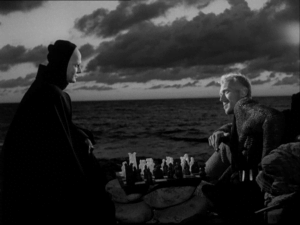
Instead of yielding to Death on the shores of his homeland, medieval knight Antonius Block challenges Death to a game. If he should win, he proposes, he can go free, and if he should lose, then he will willingly accept his fate. Amused by this proposition, Death agrees. But it is not Death that Block fears. It is the fear of having lived a meaningless existence, with nothing but a series of violent crusades behind him and a plague-ridden land ahead. Their game of chess, from its physical manifestation as a board and pieces to its symbolic significance, subsequently becomes the literal object between life and death. It is a temporary measure enacted by Block in an errant attempt to secure for himself the faith that he has lost. Every move matters, either moving him further, or closer to, a fate he gradually comes to accept as inevitable.
Whilst we witness the pair playing the game three times over the course of the film, it pays little to no attention to the chronology of the game itself, as has been noted by Stuart Reuben. However, intentional or not, the arbitrariness of the board’s pieces plays perfectly into the film’s hands. Block’s pursuit of meaning, be it incarnated in God, the Devil, or the heavens, is heavily suggestive of his desire to at least be a pawn, not a knight, in a grander scheme. His quest homeward takes him through the hierarchy of medieval society. His only companion at the beginning of the film is his squire, but he eventually acquires a family of struggling performers, a blacksmith and his wife, and a poor peasant girl. They are all inexorably swept up in his journey, their fates, save for the performers, tied to his. The lack of continuity on the chess board is thematically convenient for the film’s suggestion that in the tailspin of existence, there is no end but death.
No matter the move he makes, the game is always skewed to favour Death. Block manages to spare the life of the family by allowing them to escape whilst Death has his back turned. This qualifies as his meaningful act – one chosen willingly as opposed to divinely ordained – but still prays for himself and his doomed companions when Death finally closes in and the game comes to an end.
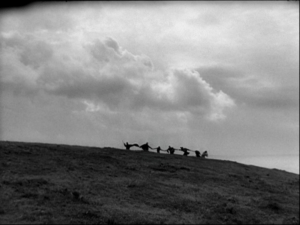
Blade Runner – 1982
Ridley Scott’s Blade Runner (1982) is another film that explores the question of a meaningful existence, albeit one set in a dystopian future as opposed to the unforgiving dark ages. Harrison Ford’s Rick Deckard is hired to hunt down and ‘retire’ a group of artificial beings called ‘replicants’. They have returned to Earth in order to find the man responsible for their creation, Eldon Tyrell (Joe Turkell), and prolong their limited four-year life-span. In order to reach him they acquire the services of one of Tyrell’s geneticists, J.F Sebastian (William Sanderson).
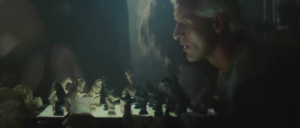
Sebastian is locked in a chess game with his superior, remarking that he’s only ever been able to beat Tyrell once. It is Roy Batty (Rutger Hauer), one of Tyrell’s own replicants, who succeeds in securing victory. Blade Runner, like The Seventh Seal, is a film that has been the subject of vast amounts of film criticism and interrogation. This likewise goes for its use of chess, which has been compared to the famous ‘Immortal Game’ between Adolf Anderssen and Lionel Kieseritzky in 1851 (Scott has apparently denied this).
Whatever the case for that comparison may be, Blade Runner’s chess game is arguably about power, and the exertion of that power over life and death. Tyrell holds both Batty and Sebastian’s future in his hands, to the extent that in Batty’s case, it is a matter of his mortality. He has succeeded in creating a being who can overcome him in intelligence, but Batty’s maker, his ‘God’, so to speak, is unable and unwilling to extend the replicants’ existence. The replicants are desperate in their pursuit to be something more than just pawns to human hands. And when science can no longer satisfy that need, they must rely on what little time they have left – on their experiences – to do so. In the end, Batty is hunted down by Deckard, but quickly turns the tables, and the hunter becomes the hunted. “Quite an experience to live in fear, isn’t it?” Batty remarks, holding Deckard’s life in his hands as he dangles from a rooftop.
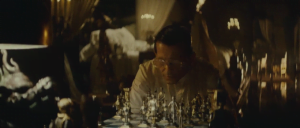
The book on which the film is based, Phillip K. Dick’s Do Androids Dream of Electric Sheep? (1968), places a far greater emphasis on animals and the status they denote to their owners. To possess a real animal is to acquire a higher status than one with an artificial animal. Acquiring a living, breathing animal with blood running through its veins is the prime motivator for Deckard, so he may replace his robotic sheep. This theme is generally absent from Scott’s film. It is only mentioned when Deckard visits Tyrell’s office and encounters a synthetic owl. On asking if it is artificial, he is countered with, “Of course it is.”
It is interesting to note, then, that the grand and baroque chess sets used by Tyrell and Sebastian are markedly different – one with human pieces, the other with animal pieces. Whilst Tyrell’s pieces are definitively human in form, Sebastian’s are ornate birds. In keeping with Blade Runner’s flirtation with noir and history, they are both anachronistic sets, but defer separate meanings on their owners. Tyrell is transfixed on the human form and likely spends more time in the company of human beings than he does replicants, but much of Sebastian’s old-world apartment is artificial and, ultimately, lonely. He does not have the luxury of owning an artificial owl as Tyrell does (let alone a real one, should they even still exist) and instead must marvel at their image on his chess board.
This post only examines in brief the potentialities of theme chess represents in these films, and only covers two to boot. There are many examples, perhaps not all of which are equally as interesting, but will very likely always serve as functional, thematic features appropriated for the cinematic medium.

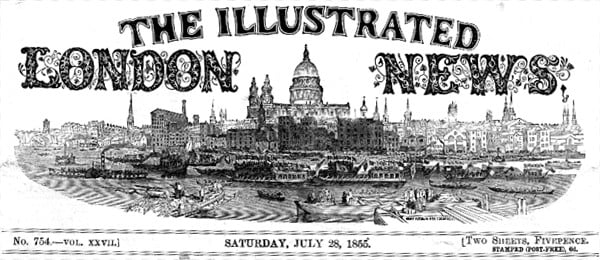
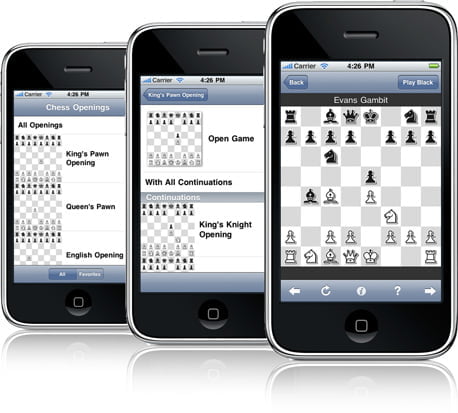
I love your stuff
Hey, Been reading your site for a while just wanted too say I enoy it as nobody seems to say positive thinbs onlie now
Honestly this is probably tthe most helpful thing I’ve read,
thanks a lot. From cold Scotland